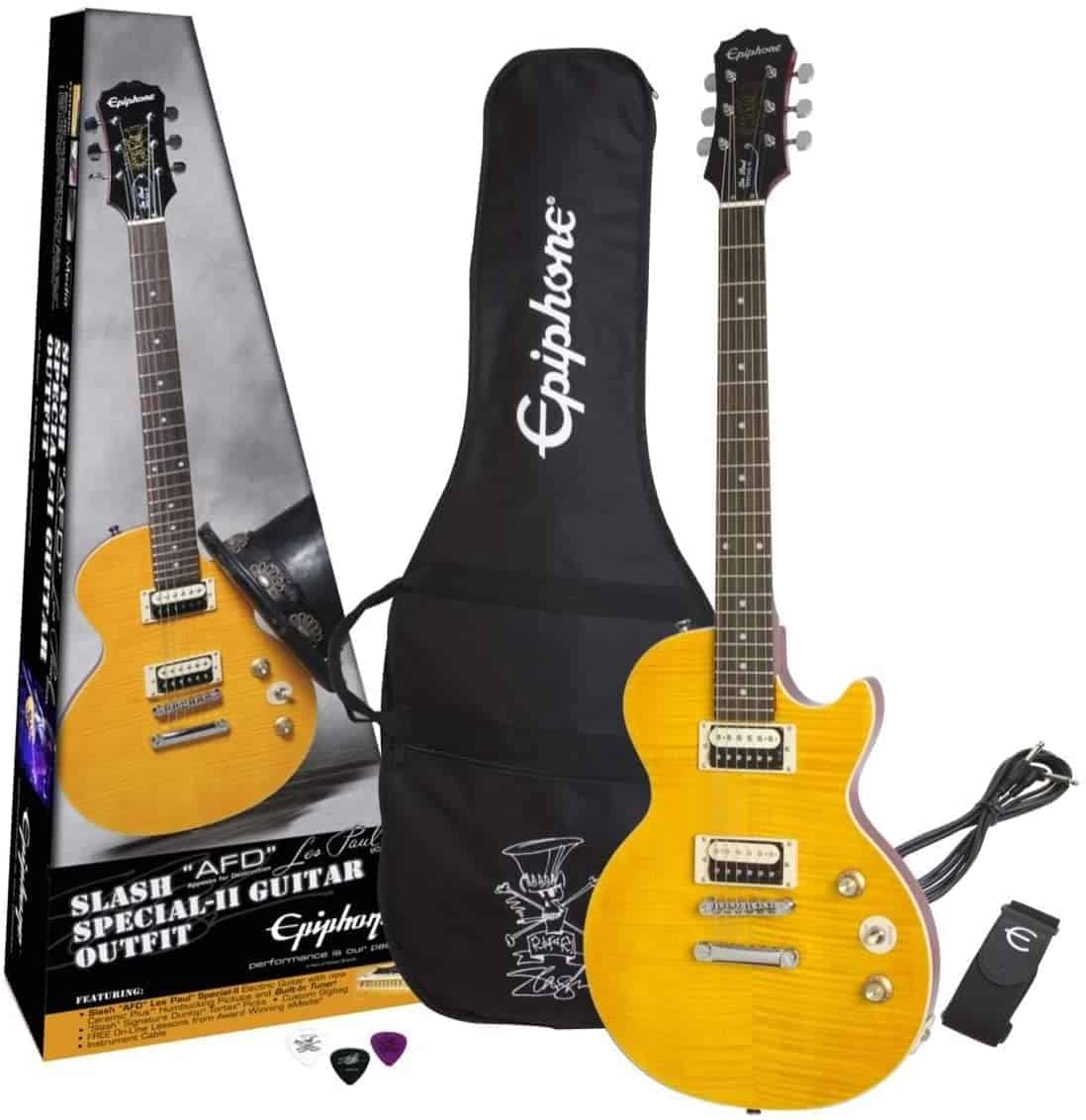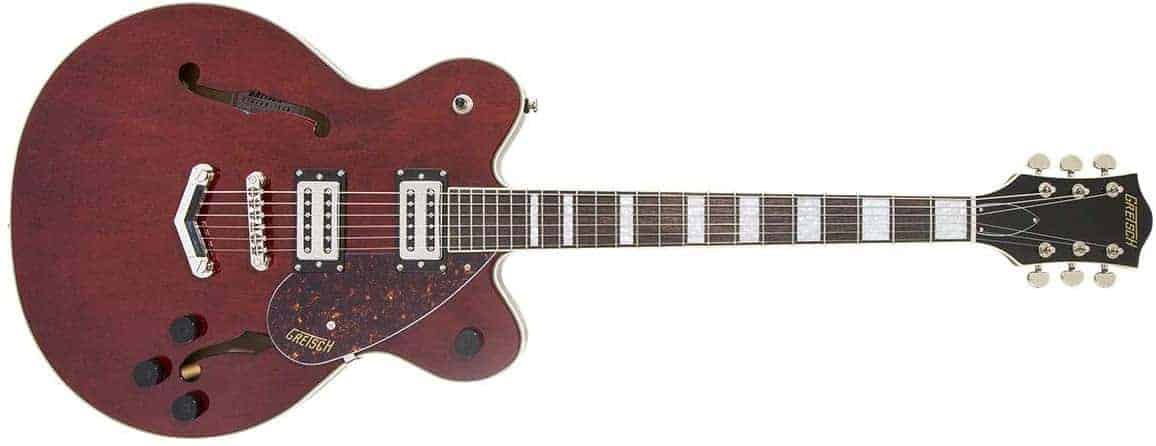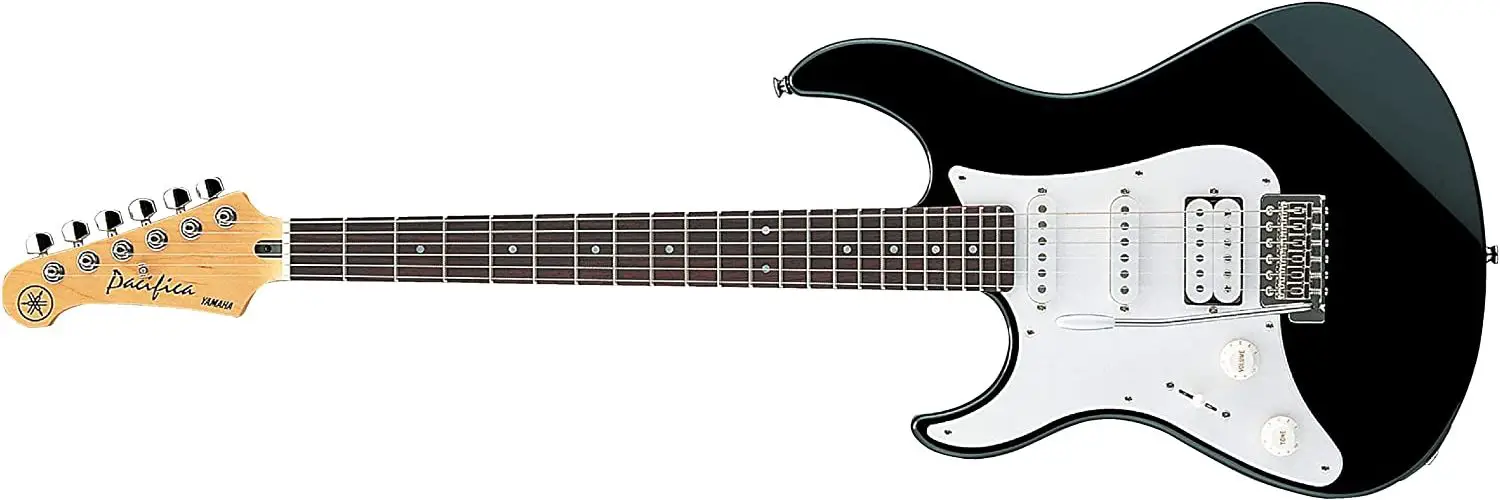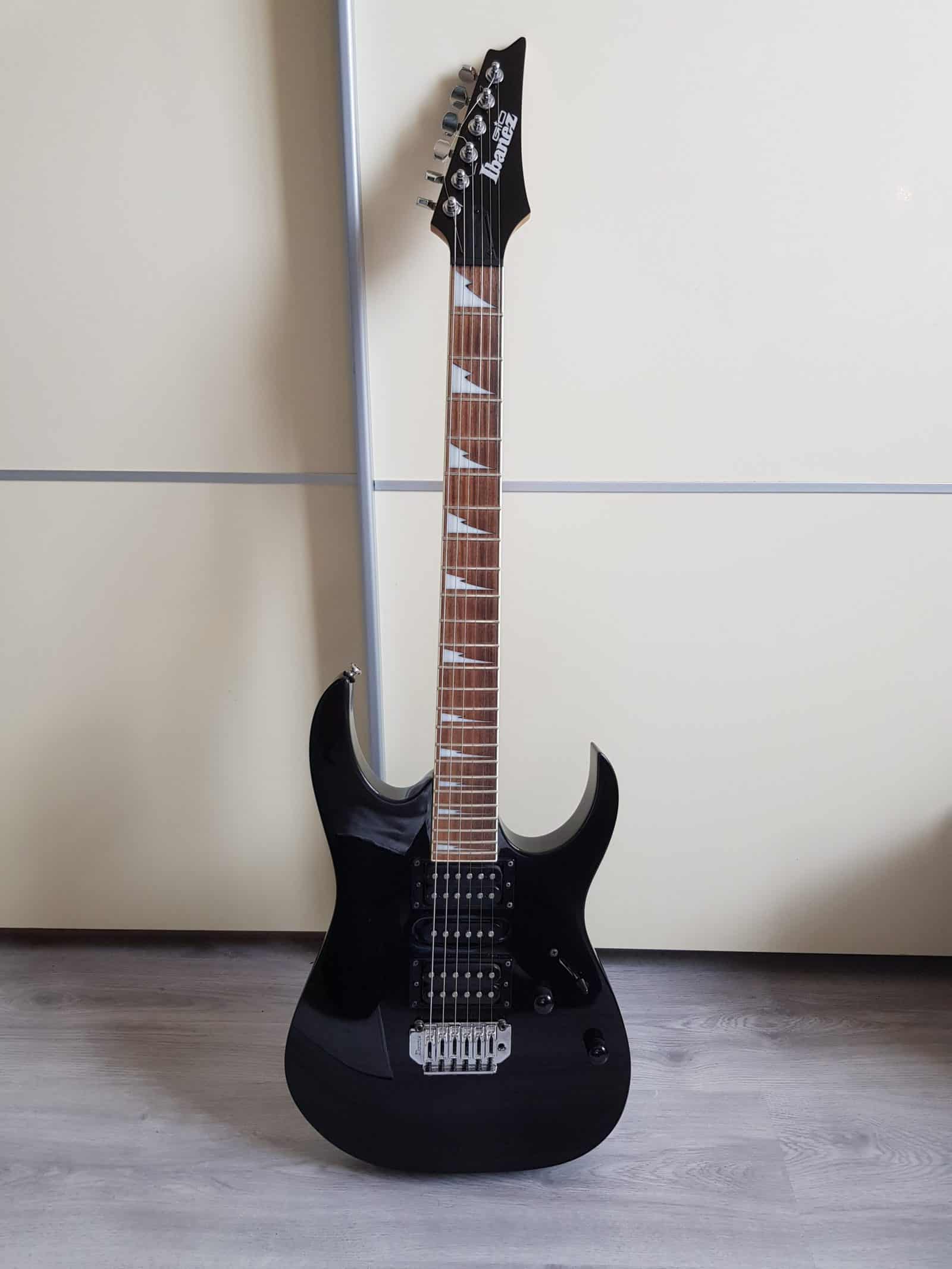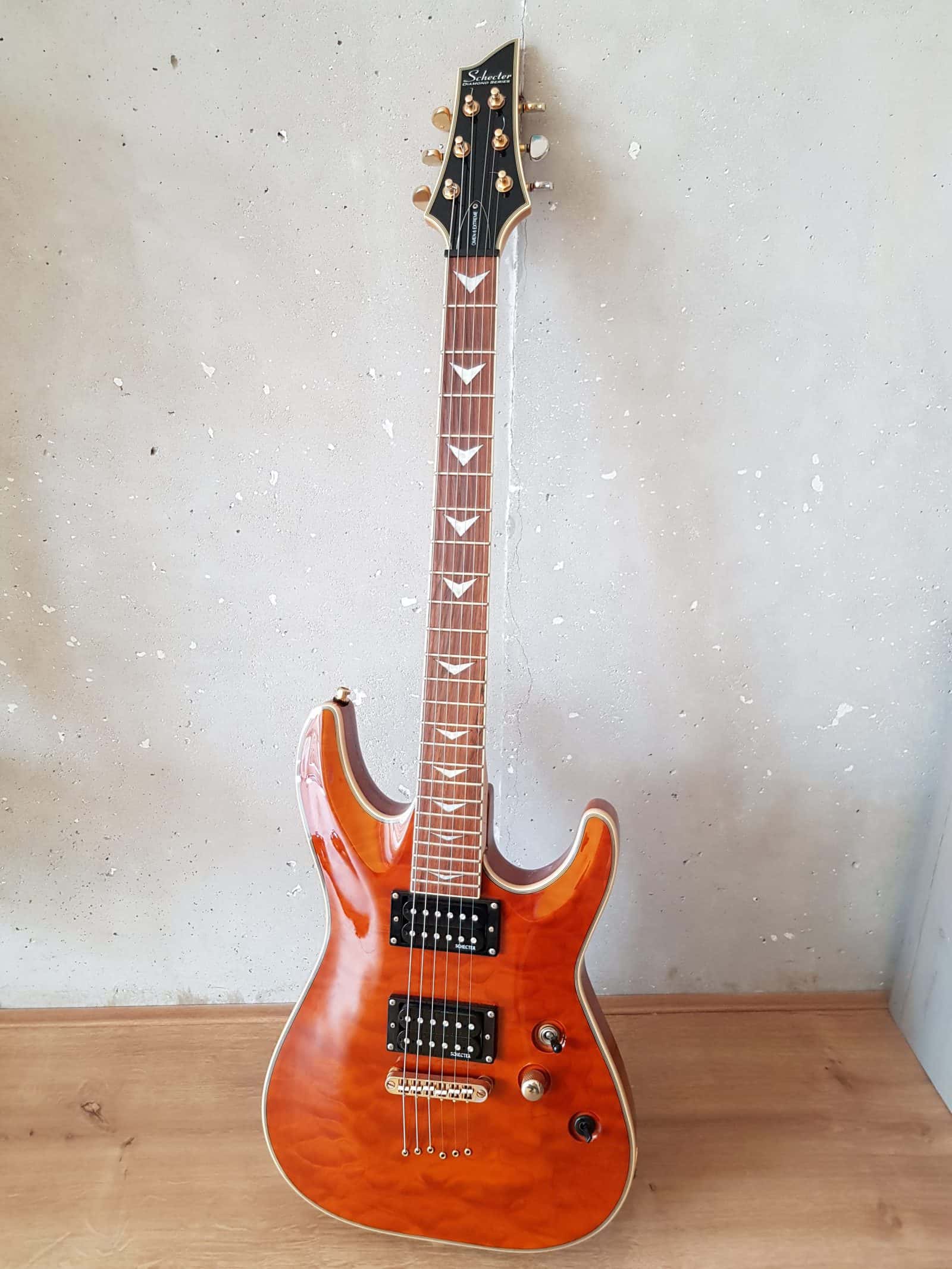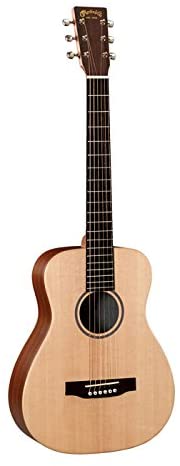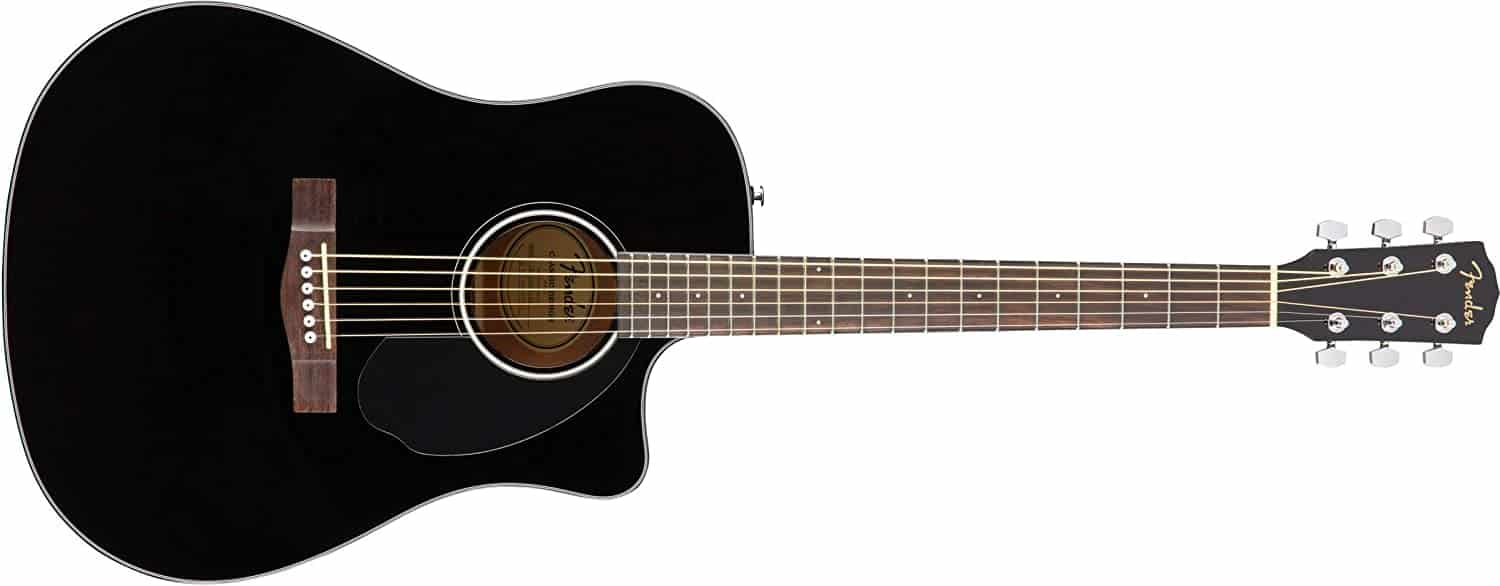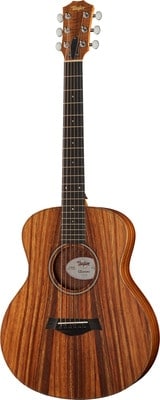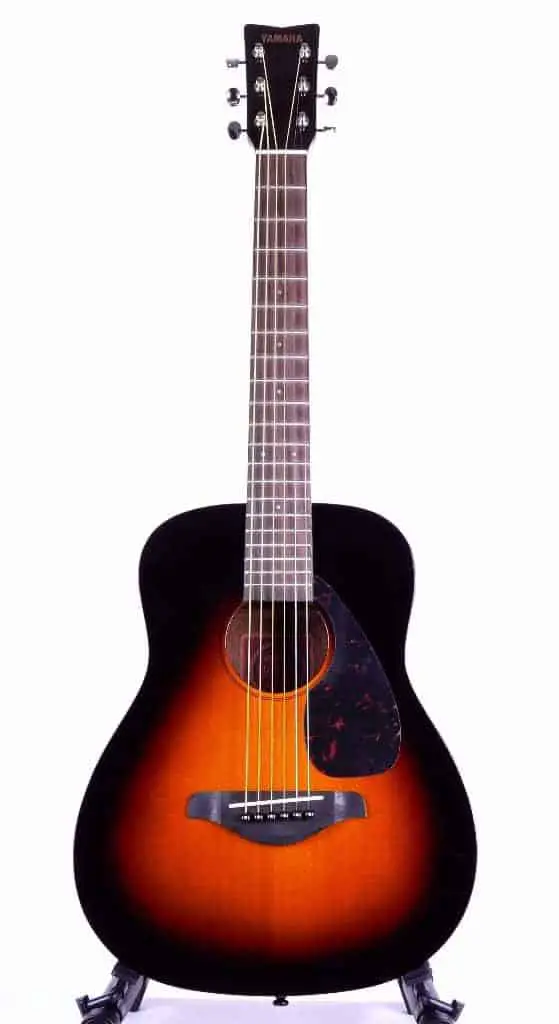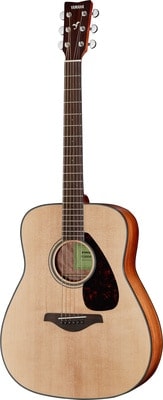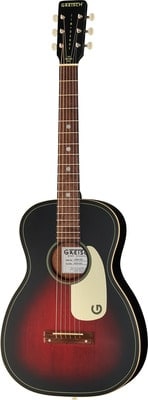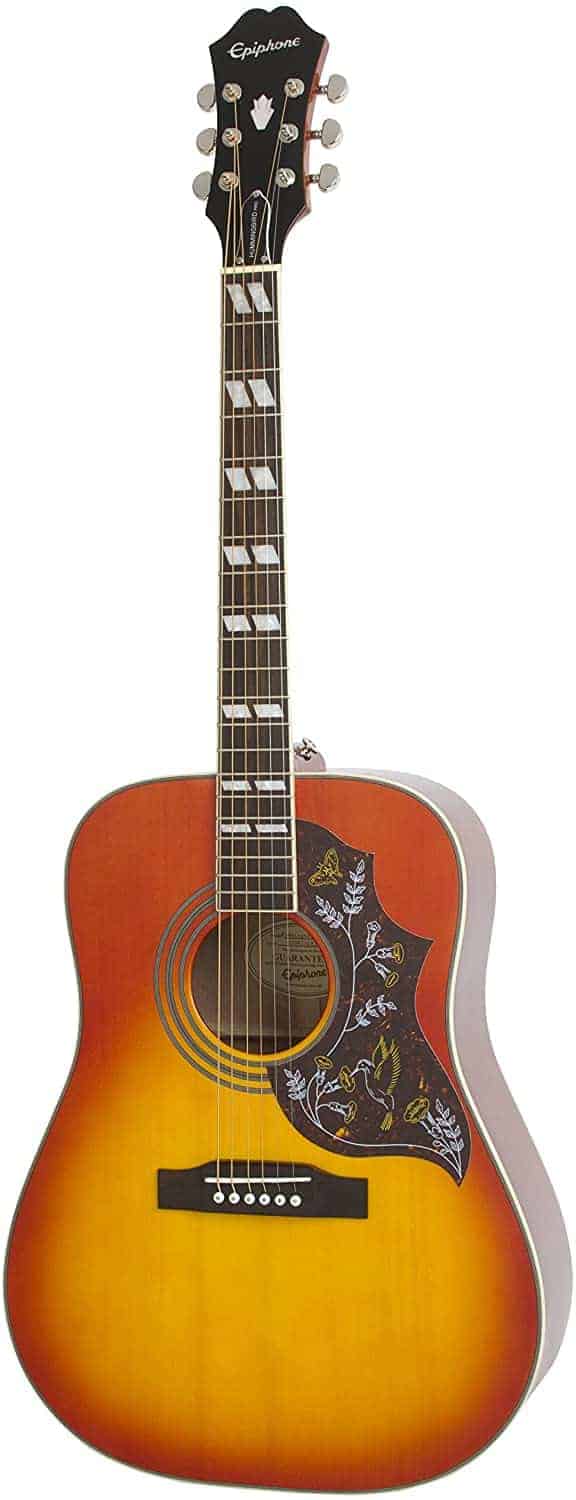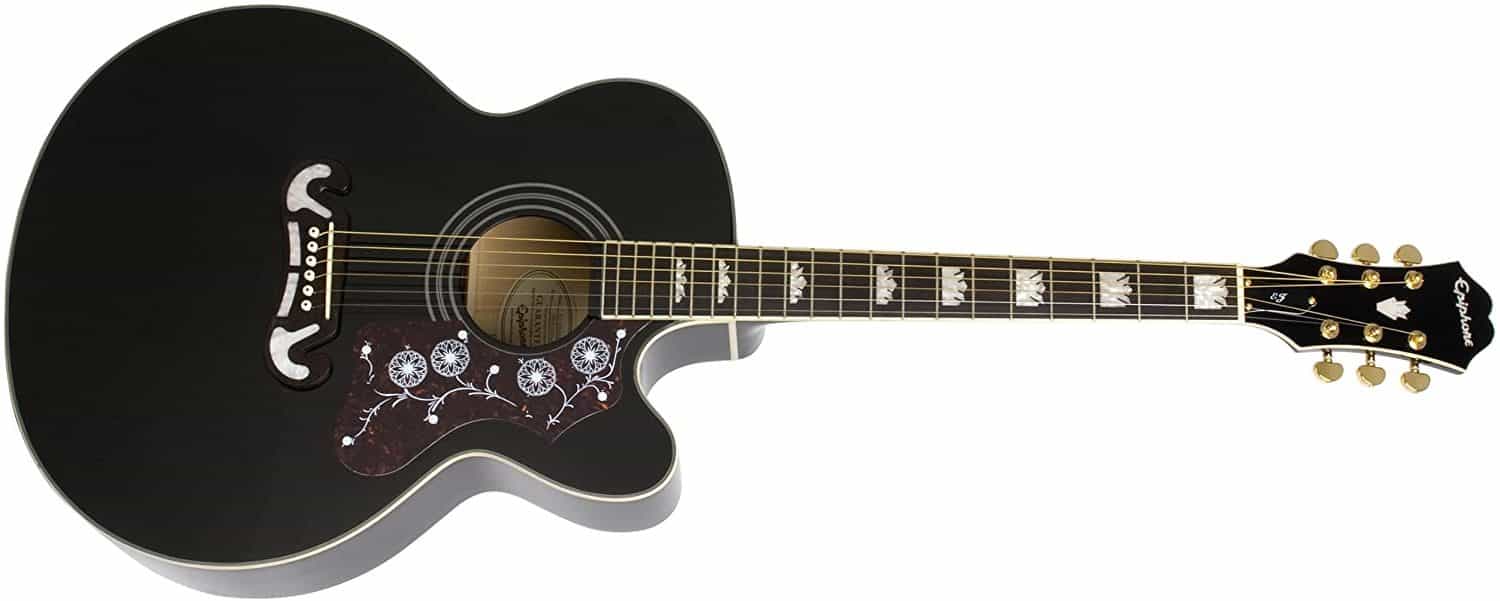Everyone has to start somewhere, and it would be nice to get a guitar that won’t get in the way of learning it best you can.
As a beginner, you probably don’t want to spend too much money, but even for your budget, there are a couple of great instruments that can help you progress.
The best electric guitar for a beginner is this Squier Classic Vibe 50s for example. Just a little more expensive than the Squier Affinity series but it gives so much more playability and sound. That will surely last you from beginner to intermediate without fail.
But in this guide, I look at acoustics as well as electrics and also have a few cheaper options. Discover some really good ones in this article on the best beginner guitars.
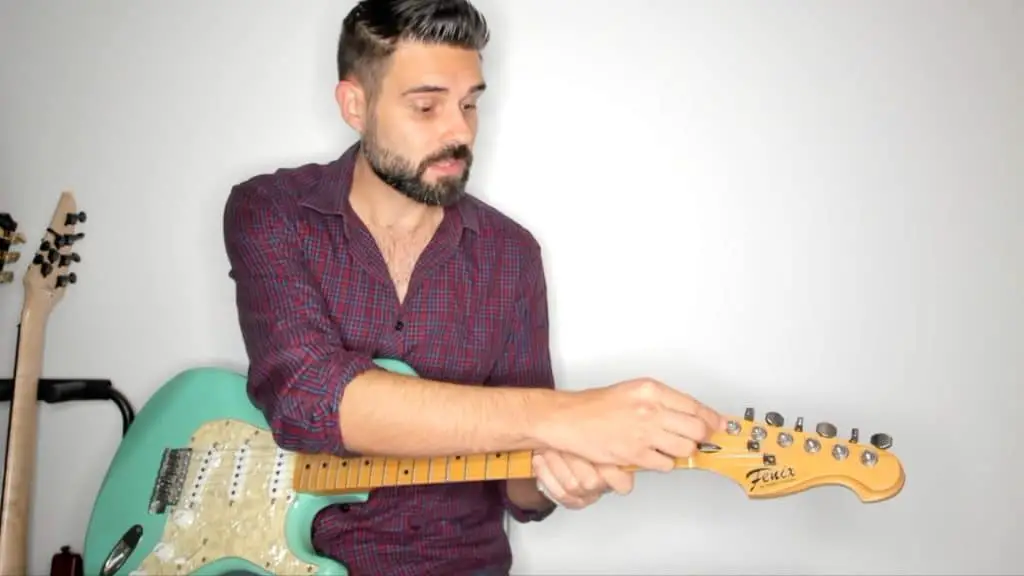
Choosing your first guitar is such a great moment, but can also be quite a daunting process.
You don’t want to make the wrong choice, waste your money, and get stuck with a beginner guitar that doesn’t suit your playing style.
Let’s take a look at the top choices for different styles real quick. After that I’ll discuss your options a little more in-depth:
Best overall beginner guitar
I like the look of the vintage tuners and the tinted slim neck while the sound range of the Fender designed single coil pickups is really great.
Best Les Paul for beginners
This Slash-model is aimed at guitarists who know they want to start out in rock, and it definitely offers the look of everyone’s favorite Guns N ‘Roses guitarist.
Best cheap beginner guitar
The original Mustang didn’t have 2 humbuckers but they wanted to add a little more versatility out of the box, with a sharp crystal tone in the bridge position and a warmer growl in the neck.
Best semi-hollow body guitar for beginners
The Streamliner concept is no-nonsense: make an affordable Gretsch without losing its specific sound and feel.
Best Fender (Squier) alternative
For those looking to buy their first guitar and not want to spend a lot of money, the Pacifica 112 is an excellent option that you won’t be disappointed with.
Best beginners guitar for metal
The GRG170DX may not be the cheapest beginner guitar of all, but it offers a wide variety of sounds thanks to the humbucker – single coil – humbucker + 5-way switch RG wiring.
Best beginner guitar for rock
We are talking about a custom Super Strat design, which combines several great functions. The body itself is crafted from mahogany and topped with an attractive flamed maple top.
Best electro-acoustic guitar for beginners
In terms of acoustic guitars, this Martin LX1E is one of the best guitars for beginners and an excellent instrument for players of any age or skill.
Best cheap acoustic guitar for beginners
Solid wood mahogany top, though the back and the sides of the guitar are laminated mahogany. The fretboard feels comfortable and this is probably due to the specially bound fretboard edges.
Best acoustic beginner guitar without pickups
The GS Mini is small enough for anyone to be comfortable with, yet still produces the kind of tone that will make you weak in the knees.
Best beginner guitar for kids
The material used to make this guitar are absolutely of the highest quality and slightly higher than the wood used in the JR1. That bit of extra money is going to help so much in enjoying playing and learning.
Budget Fender alternative
This affordable model from guitar giant Yamaha is a quintessentially stylish, clean acoustic construction with a matte finish that gives a lived-in “used” guitar look.
Best acoustic parlor guitar for beginners
Sound wise this acoustic guitar is great; airy, clear and sparkling, without the harshness you would expect from a combination of spruce and laminate.
Best cheap electro-acoustic beginner guitar
If you’ve heard of The Beatles, or Oasis, or Bob Dylan, or almost every classic rock act of the last 60 years, you’ve heard some famous Hummingbird acoustics in action.
Best jumbo acoustic guitar for beginners
The Fishman Sonitone pickup system gives the option of 2 outputs, simultaneously stereo where you can blend the two to your taste, or separately through the two outputs to mix each in the PA.
Before I get into the full reviews, I also have some more advice to help you choose the right beginner guitar.
How to choose a beginner guitar
It can be difficult to know what to look for when researching good guitars for beginners for the first time.
But fear not. Whether you’re looking for an acoustic or electric guitar, I’ve got you covered.
Many beginning guitarists choose to start with an acoustic guitar:
- It is certainly the cheapest option
- you don’t have to buy a separate guitar amplifier
- you can start playing immediately
Electric guitars also have more components to learn and understand, but they are also more versatile, especially if you want to play rock or metal, so those are great guitars for beginners too.
Fortunately, there has never been a cheaper or more convenient time to start with the electric guitar.
The quality available for this price range is better than ever. Some of these beginner guitars might be lifelong companions, so investing just that little bit more might be worth it.
Acoustic vs Electric Guitar
First of all, the choice you have to make when choosing a beginner guitar is whether you want to go acoustic or electric.
While both provide the experience you’re looking for, there are some fundamental differences.
The most obvious is the sound:
- Acoustic guitars are designed to operate without amplification. This means they are much louder and do not require additional gear.
- Electric guitars, on the other hand, can be played without being amplified, but only to practice. However, plug one into an amplifier and you get a full range of sound.
By the way, I always liked the extra quietness of an unamplified electric guitar when practicing in my room.
That way I didn’t disturb anyone when practicing my riffs late at night. That’s not possible with an acoustic guitar.
You’ll also likely find electric guitars easier to handle due to their thinner necks and smaller form. They’re also a bit more forgiving when playing notes due to being amplified.
What you need to know about beginner acoustic guitars
You can choose something under 100.- with terrible string action and playability, but chances are that you’ll find it a struggle to play and eventually decide that guitar is not for you.
That’s why I can’t recommend any of those.
The class above 100.- has much more value for money.
Buying an acoustic guitar for beginners is easier than many other instruments. Keyboards, drum kits, electric guitars, and DJ equipment have many variables. With acoustic guitars, it’s a lot easier.
Sound quality and size
Acoustic guitars are known for their projection and rich resonance.
An acoustic guitar of any caliber, from the cheapest to the most expensive, should be able to produce a warm sound with plenty of volume.
Factors such as body shape also play a role. The large “jumbo” acoustics produce a much wider sound with a pronounced bottom-end bass sound.
This acoustic style works well for band use, where the guitar’s sound is less likely to be lost in the mix with the other instruments.
They’re also much larger physically, making it difficult for young learners to play.
At the other end of the scale are travel guitars or “parlor” guitars, which have a much smaller body.
These have a thinner sound with less volume but are easier for younger players to take to lessons or band practice.
Tonewood
The wood the body is made out of will affect the tone of the guitar the most. This is also where you’ll see the most difference between very cheap and moderately prices ones.
All acoustic guitars in this price range will have laminated bodies, a step down from a solid wood build but there’s no need to worry about that here.
Mahogany is a great affordable wood for a warm, balanced sound. Cheaper guitars might be made of poplar.
Playing style
You should also consider your playing style.
If you want to learn fingerstyle guitar then an acoustic parlor style might be the answer.
The slightly shorter body length here means they can be played sitting down for extended periods. They also produce a more complex sound that doesn’t reverberate as much.
In the center of the group is the dreadnought shape. These are the “Everyman” of the acoustic guitar world, offering a great balance of size, tone, and volume.
You can also consider whether you just want to play with your guitar or maybe record with it.
If so, look for an acoustic guitar with built-in electronics, as you can connect it to an amp or recorder in the same way as you would an electric guitar.
Larger body guitars produce a much fuller, rounder sound with pronounced bass tones.
These are great for strummers or anyone looking to join a band with chords. The downside is that they can be cumbersome.
Playability and action
Aside from body shape, you’ll want to look at the guitar’s neck and fingerboard, and the distance between the strings and frets.
I have seen so many times when someone who wants to learn to play guitar drops out because they are put off after playing acoustic guitar strings that feel like steel wire and need to be pressed way too hard for a beginner.
For this reason, electrics are often a better bet for many learners because they are often adjustable and able to get lower action.
What you need to know about electric guitars for beginners
Novice guitarists have much to choose from regarding the range, quality, and performance of entry-level instruments. So whatever you want to learn, there is always something for you.
Electric guitars come in many different shapes and sizes, but there are a few basic points that are common to any guitar.
Sound quality
The most important things about the guitar’s sound quality are the wood of the body and the pickups.
Pickups translate your playing into an electrical signal that an amplifier converts into sound. They affect the quality of the electric signal so pay attention to these.
- Single-coil pickups suit various playing styles such as rock, jazz, funk, and blues.
- Humbuckers, on the other hand, produce a thicker, rounder sound that works well for heavier styles of music such as hard rock and metal.
Wood is the second thing that affects sound. Ash is a great wood for lighter types of music and mahogany for heavier types, but there is a lot more to it than that.
Basswood is a much cheaper wood but can sound a bit muddy. Meaning it doesn’t have very defined mid-tones.
At the start of your playing career, some factors that more experienced players prefer, such as different woods for bodies and necks, are less important to consider when choosing the best beginner guitar.
The most important thing is a comfortable guitar that sounds good but plays great to keep you returning to it.
Playability
Electric guitars also have thinner necks than most acoustic guitars, which makes them a good choice if you’re a beginner.
I actually had to start on acoustic guitar because the music school here didn’t start teaching electric guitar from age 14 for some reason.
But electrics do make the best guitars for kids and people with small hands because of the easier necks. Especially ‘short-scale’ models like the Bullet Mustang I’ll talk about a bit more in the review section.
A shorter scale means the frets are closer together, making it easier to play chords and reach more notes.
Best 15 Guitars for Beginners Reviewed
As with anything you get what you pay for, but with this list of the best guitars for beginners, I think I’ve hit the sweet spot between price, performance, and playability.
These are the best guitars for beginners right now, I’ll break them down into electric and acoustic:
Squier Classic Vibe ’50s Stratocaster
- Great value-for-money
- Leaps above the Squier Affinity
- Fender designed pickups sound great
- Nato body is heavy and not the best tone wood
I wouldn’t buy the affinity guitars. My preference in a lower price range strat goes to the Yamaha 112V for that, which offers a better build quality.
But if you have just a little more to spend, the Classic Vibe series is awesome.
I like the look of the vintage tuners and the tinted slim neck while the sound range of the Fender designed single coil pickups is really great.
I would go so far as to say that the classic vibe range as a whole has much more expensive guitars, including Fender’s own mexican range.
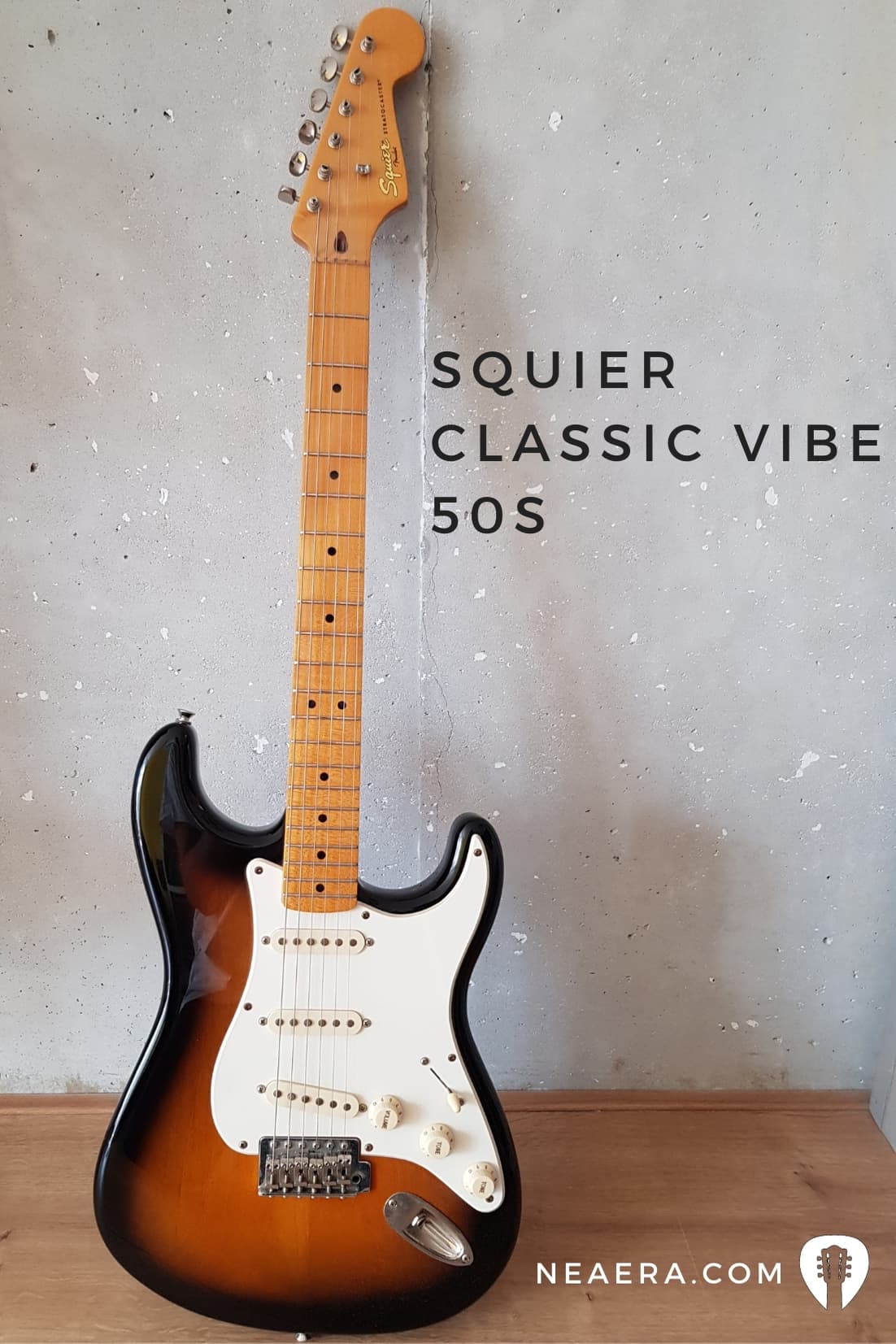
The combination of excellent build quality, excellent tones and stunning looks makes for an attractive package, and one that you are unlikely to grow out of anytime soon.
If you are just starting to play and have no idea what style you want to play, the stratocaster is probably the best option for you because of its versatility and the tone you are likely to hear in a lot of your favorite music.
The guitar offers a nato body with maple neck. Nato and maple are often combined to get a more balanced tone.
Nato is often used for guitars because of the similar tone properties to mahogany while being more affordable.
Nato has a distinctive sound and parlor tone, which results in a less brilliant midrange tone. Even though it’s not as loud, it offers a lot of warmth and clarity.
The only disadvantage is that this wood doesn’t offer many lows. But it has a great balance of overtones and undertones, perfect for higher registers.
I particularly like the vintage tuners and the tinted slim neck, while the sound range of the Fender designed single coil pickups is great.
- The Affordable Strat Experience
- Excellent price / quality ratio
- Authentic looks
- But not many extras for this price
It’s a really nice beginner Squier that will grow with you for a long time to come and I would certainly invest a little more in this one than in the Affinity range so that you have a guitar for life.
Epiphone Slash ‘AFD’ Les Paul Special-II
- Tuner built in
- Beautiful finish at this price
- Pickups can sound dark and muddy
- Okoume AAA flame maple body
- Okoume neck
- 24.75″ scale
- Rosewood fretboard
- 22 frets
- 2 Epiphone CeramicPlus pickups
- Volume and tone pots
- 3-way pickup selector
- Shadow E-Tuner on pickup bridge ring
- 14: 1 ratio tuners, Tune-O-Matic bridge and Stopbar tailpiece
- Left-handed: No
- Finish: Appetite Amber
This Slash-model is aimed at guitarists who know they want to start out in rock, and it definitely offers the look of everyone’s favorite Guns N ‘Roses guitarist.
To match the looks with an incredible sound, they added two Epiphone Ceramic Plus humbuckers.
Since they know it’s aimed at beginner guitarists, there’s also a Shadow E-Tuner built into the bridge’s pickup ring, which you can activate with a simple push of the button on the ring.
While you can buy tuners for the headstock or already have access to one in many of your favorite multi-effects pedalboards (which you should also get as a beginner guitarist), it is incredibly useful for beginners to always have a tuner on hand.
The action (how high the strings are) is low enough for beginners and suits most players, and the pickups can get a nice high gain, enough for a good rock guitar tone, although the neck humbucker is a bit dark and muddy at times.
- Excellent quality for the price
- Simple control system: great for beginners
- Built-in tuner
- But a muddy sounding neck pickup
It is the best Les Paul on our list but not the best overall, but any doubts you might have will fade away when you see the low price tag on this instrument.
Squier Bullet Mustang HH
- Best value-for-money we’ve seen
- Short-scale makes it great for younger players
- Basswood body isn’t very defined
- Basswood body
- Maple neck
- 24″ scale
- Laurel fretboard
- 22 frets
- 2 high-gain humbuckers
- Volume and tone pots
- 3-way pickup selector
- Modern hardtail bridge with standard tuners
- Left-handed: No
- Imperial Blue and Black finishes
The original Fender Mustang was a cult classic, loved by alternative bands throughout the 90s. Guitarists like Kurt Cobain loved it for its short scale and looks.
This is yet another guitar from Squier that made it on our list, but the Bullet Mustang is aimed at a lower price segment than the Classic Vibe series.
Like most of Squier’s entry-level guitars, it features a basswood body, known to have this great light feel to it.
Having a nice and light body and a short 24-inch scale length makes it a good choice for beginners and for kids.
The original Mustang didn’t have 2 humbuckers but they wanted to add a little more versatility out of the box, with a sharp crystal tone in the bridge position and a warmer growl in the neck.
It has a bolt-on maple neck and a solid six-saddle hardtail bridge which makes this guitar very sturdy for those wanting to do some heavier music, and the tuners are pretty decent in holding the correct pitch.
- Short scale length is great for beginners
- Lightweight body
- Comfortable neck and fingerboard
You will want to upgrade the pickups at some point if you plan on keeping this guitar as you progress because they can be a bit disappointing.
Gretsch G2622 Streamliner
- Great build-to-price ratio
- Semi-hollow design gives great resonance
- Tuners are below par
- Body: Laminated Maple, Semi-Hollow
- Neck: Nato
- Scale: 24.75 “
- Fingerboard: rosewood
- Frets: 22
- Pickups: 2x Broad’Tron humbuckers
- Controls: Neck Volume, Bridge Volume, Tone, 3-Way Pickup Selector
- Hardware: Adjusto-Matic bridge, ‘V’ stop tail tailpiece
- Left-handed: Yes: G2622LH
- Finish: Walnut stain, black
The Streamliner concept is no-nonsense: make an affordable Gretsch without losing its specific sound and feel.
And Gretsch did that with the Streamliner for its semi-hollow design. This gives you a little more volume just playing it without an amp (it’s no acoustic mind you) and offers a nicer, less aggressive tone than a solid body guitar when plugged into an amp.
The sound it produces is great for softer blues and country style music.
This type of guitar does have a somewhat thicker neck than the other electrics I’ve covered here, so it’s not one of the best guitars for small hands or for kids.
The build of this G2622 gives a bit of a different sound and resonance than other models from Gretsch, which makes it more versatile but less of the authentic Gretsch sound, so I’ve added it to the list, not as the best cheap Gretsch but as a versatile semi-hollow for beginners.
The sound more leans towards the recordings you might here from a classic Gibson ES-335.
The Broad’Tron humbuckers look the part and provide ample output for numerous styles.
- Build-to-price ratio is very high
- Hotter pickups broaden the sonic potential
- Center Block increases usage at higher gain / volume
- A bit light rickety tuners
If you want an affordable semi-hollow body, this is one of the best affordable electrics out there.
Yamaha Pacifica 112V
- Coil split at this price
- Very versatile
- Vibrato isn’t great
- Goes out of tune easily
If you’re looking for good budget options for an electric guitar, you’ve probably come across the Yamaha Pacifica name a few times.
It ranks alongside the Fender Squier series of guitars as one of the most popular in the price range due to its quality construction and excellent playability.
The Yamaha Pacifica has long set a benchmark for quality and the 112V remains one of the best guitars for beginners.
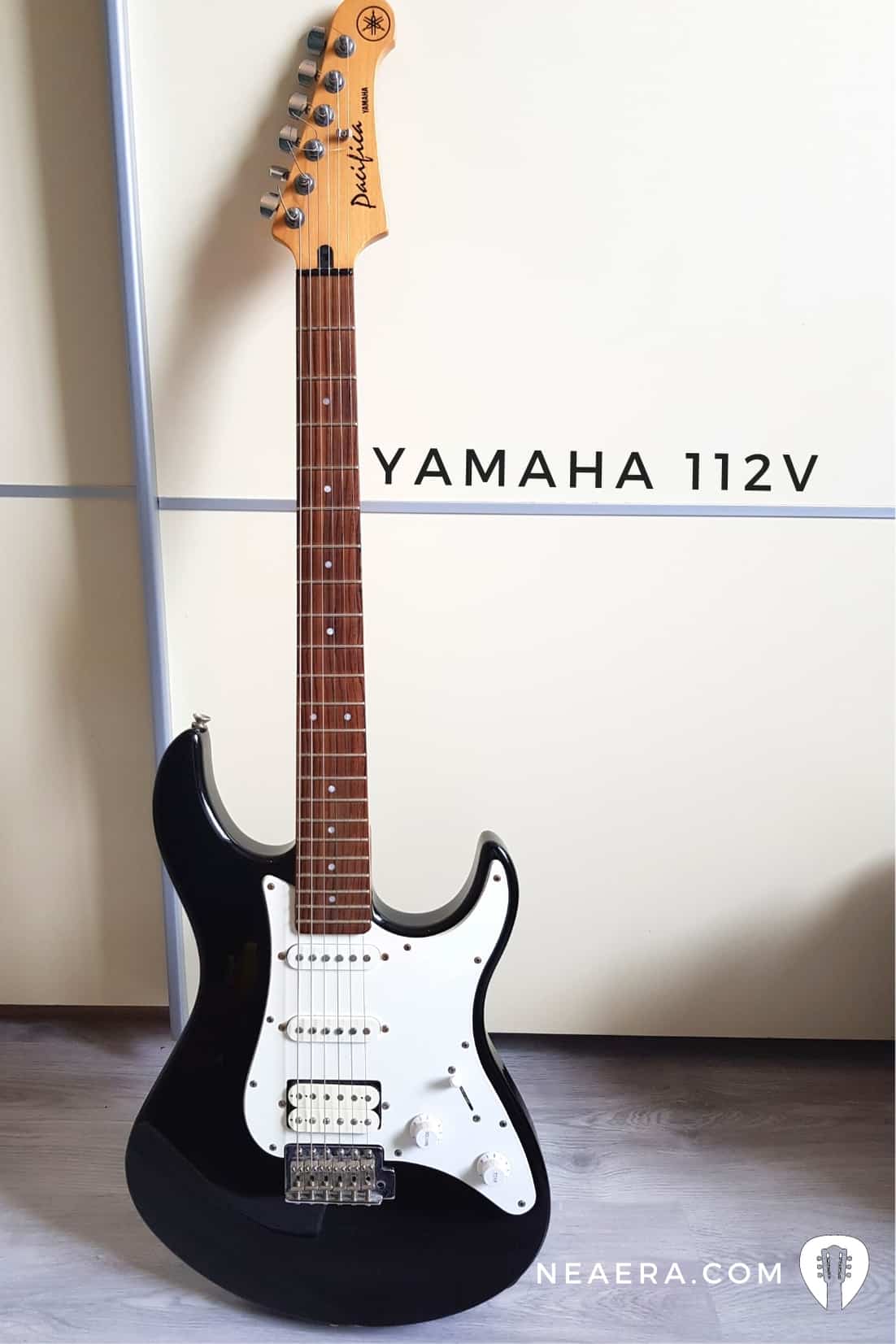
The design makes it a more modern, brighter and lighter take on a hot-rod Strat. But when I say brighter, it doesn’t mean overly shrill.
The bridge humbucker will pleasantly surprise most; it’s beefy without being too mid-tone heavy, and has a coil split on the 112V, which essentially transforms its bridge humbucker into a single coil, for more versatility.
The single-coils have great twang and tone with plenty of percussion for funky style licks, and are easily moldable with a little extra gain from your amp to get a nice growly blues sound.
Neck and middle combined produce a nice modern Strat-esque mix and the added clarity will cut nicely through a multi-FX patch.
- Ideal for beginners
- Impressive build quality
- Modern sounds
- The vibrato could be a bit better and I wouldn’t use it too much
Yamaha Pacifica vs the Fender (or Squier) Strat
Most of the Pacificas you will see are modeled after the Stratocaster body, although there are quite a few differences worth noting.
First, although the body is similar, if you look closely, not only are the horns longer on the Pacifica, but the contours aren’t as pronounced either.
Instead of connecting the guitar to the pickguard on the front as is usual on the Strat, the Pacifica has the plug on the side.
Finally, one of the biggest differences between the Stratocaster and the Pacifica is the pickups.
While Stratocasters are equipped with three single-coil pickups, the Pacifica works with two single-coils and one humbucking pickup.
Due to the coil split for the humbucker at the bridge, which you can change by pushing or pulling one of the buttons, you have the choice between a brighter country sound or a deeper rock sound.
I must say that the only sad thing is that when you switch between a single coil, for example in the neck position, to the humbucker in the bridge, the volume also gets a bit louder.
You might be able to use this in your solos, but I find it a bit annoying to keep the same volume level.
The changes in tone while playing with the different pickup settings are often subtle, but the balance between midrange, bass and treble doesn’t disappoint.
The 112 is the next step up on the 012 and is generally a more popular electric guitar. Aside from the standard alder body and rosewood fingerboard, the 112 also comes with more color options.
For those looking to buy their first guitar and not want to spend a lot of money, the Pacifica 112 is an excellent option that you won’t be disappointed with.
Ibanez GRG170DX GIO
- Great value for money
- Sharkfin inlays look the part
- HSH setup gives it a lot of versatility
- Pickups are muddy
- Tremolo is pretty bad
The best electric guitar for aspiring metal-heads
It is a classic Ibanez metal guitar with a basswood body, medium frets on a rosewood fingerboard, and the iconic Sharktooth inlays that give it an instant metal look.
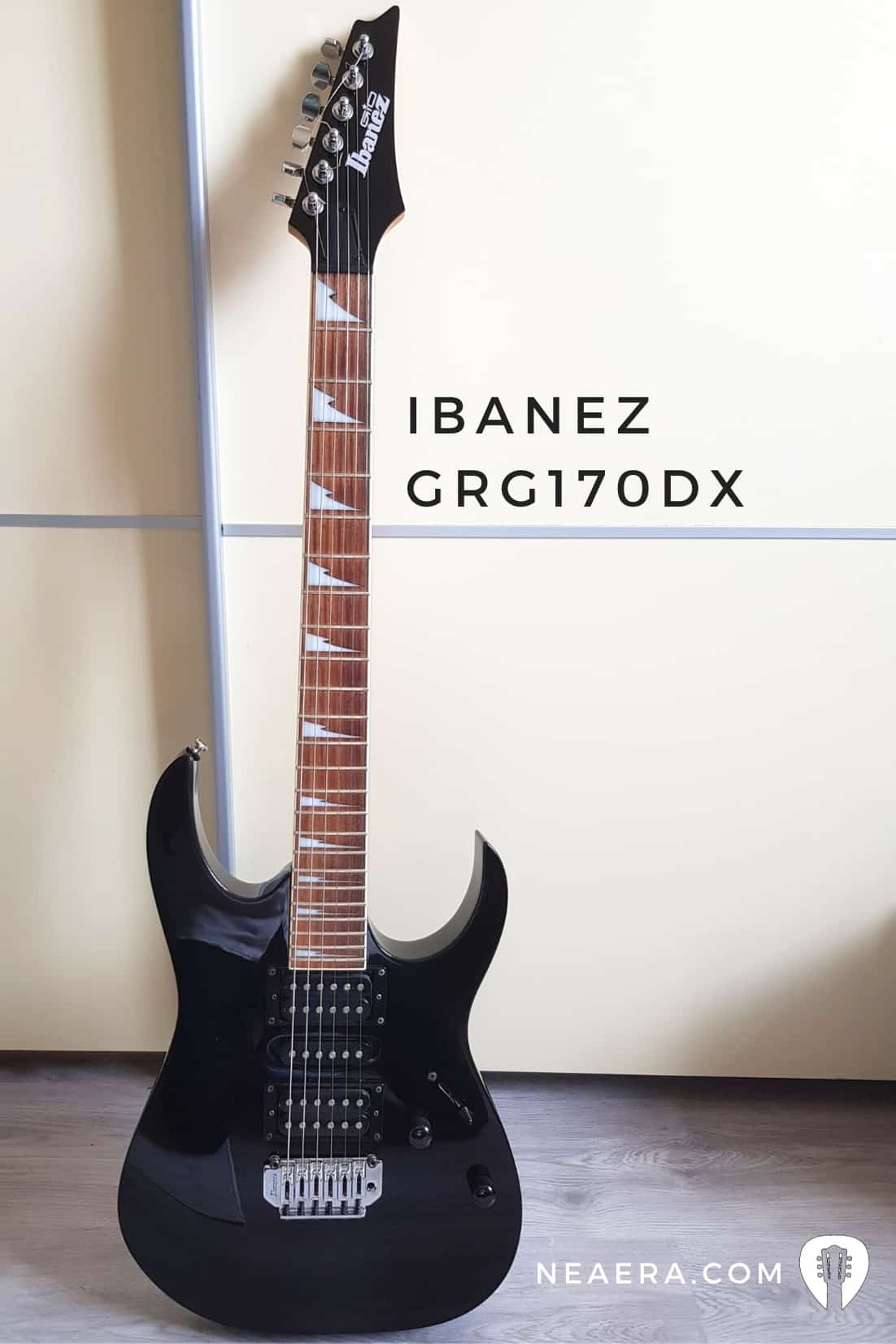
The sound is quite good considering the price with its PSND pickups. It’s nothing special, but it’s not bad. The neck humbucker has a fairly nice round sound but is a bit muddy when used on lower strings.
If like me, you like to switch from the bridge to the neck humbucker when you go to higher notes in riffs or in your solos, it gives a nice full sound.
The middle single-coil is a bit pointless because it doesn’t sound that good to play with a lot of drive and if you want to get a kind of bluesy sound then this pickup sounds too metal-ish.
For a blues sound, it is better to use a different guitar, although in combination with the bridge it sounds very good for a clean setting.
The sustain on this guitar could be better as the notes drop dead in about 5 seconds, but overall the sound isn’t bad in this price range.
This guitar is very easy to play compared to other guitars (some even more expensive) that I have played. The action is low and there is not much friction on the fingerboard.
The guitar also has 24 frets which come in handy from time to time, although the 24th fret is so small that it is very difficult to play and won’t last for more than a second or two.
The tremolo on the guitar sounds fine, but don’t expect any miracles from the tuning. If you want to take dive flights a la Steve Vai then your guitar will certainly come back up in tune, but for smaller whammy’s it is doable.
The super-strat shape, Sharktooth inlays, and gloss black finish are very nice and the back of the neck is a light wood with cream binding.
This is quite a good guitar for its price for the entry-level metal fan and although the floating bridge takes a bit of getting used to with tuning it is great value for money.
- Great for power chords
- Thin neck
- Easy access to top frets
- Not the most versatile guitar tonally speaking
Schecter Omen Extreme 6
- Most beautiful guitar I’ve seen in this price range
- Very versatile with coil-split to boot
- Pickups are a bit lacking in gain
Schecter started the company as a custom shop for guitars and has produced many replacement parts for leading guitar brands such as Gibson and Fender.
But after gaining a lot of experience in the market, they started producing their own guitars, basses, and amps.
Over the past decade, their success has been huge in metal and rock guitar circles, and their guitars gave the metal genre a much-needed breath of fresh air.
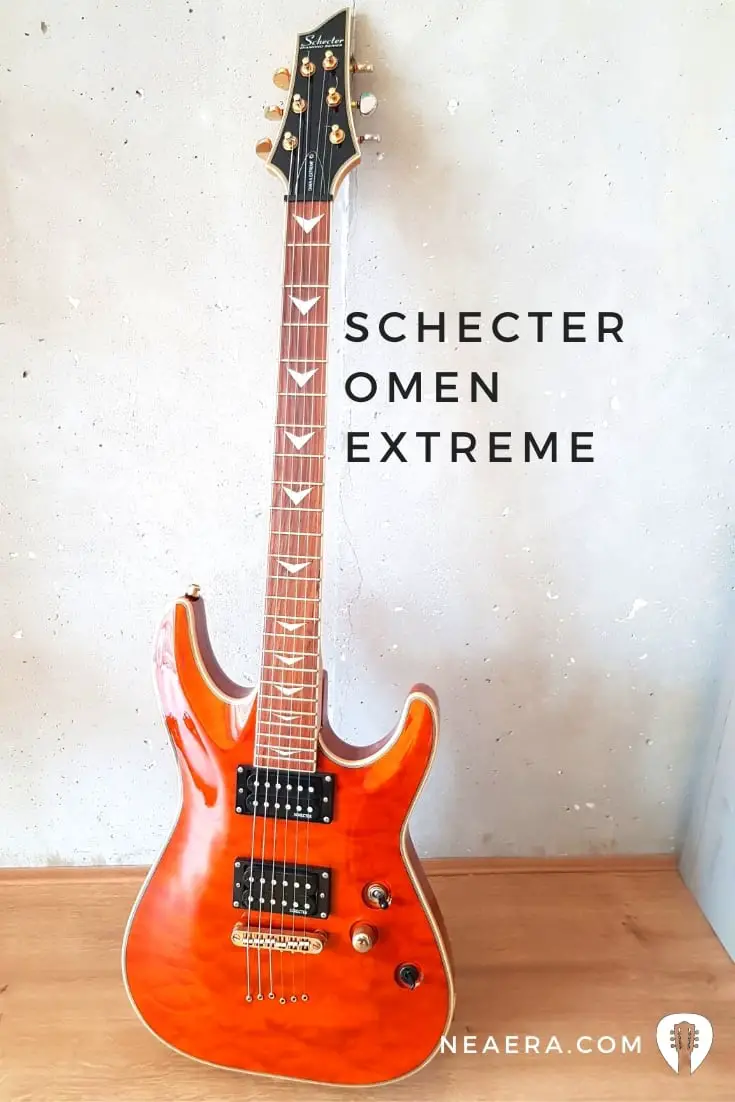
The Schecter Omen Extreme-6 is an excellent example of their quality yet affordable guitars, it is packed with features that modern guitarists want and they have a great design in this price range.
It is probably not only the best beginner guitar for rock but also the most beautiful starter guitar you can buy on a small budget.
Since their beginnings as luthiers, Schecter has stuck to simple body shapes and designs.
The Schecter Omen Extreme-6 has a super simple super strat shape that is slightly more curved to provide some extra comfort.
This guitar uses mahogany as the tonewood and is covered by the attractive maple top, this tonewood gives this guitar a very powerful sound and long sustain that heavy rock guitarists will love.
The maple neck is quite solid and is shaped to provide some speed and accuracy for solos in addition to nice solid chords, and is tied together with abalone.
The fretboard is just beautifully done with what Schecter calls “Pearloid Vector inlays”.
No one will argue when I say that the Schecter Omen Extreme-6 looks extremely elegant and suitable for any band, regardless of genre.
In addition, it offers excellent comfort thanks to its lightweight, well-balanced shape and offers great playability, which is one of the most important features of a guitar.
The company has topped this guitar off with a pair of Schecter Diamond Plus passive humbuckers, which may look low-profile at first, but wait until you hear what they can offer you.
They have a high-quality alnico design and offer a wide range of tones and sounds, they cover everything you could want from a guitar under $500.
Many guitarists call this Schecter guitars metal guitars and it is also in my list of best metal guitars, although I think it is more of a rock instrument.
Maybe the humbuckers have the tone of the old heavy metal, which required less distortion than what is nowadays metal, but I think with the single-coil position it has a nice raw blues tone, and with the humbucker position it has a nice rock growl.
There are two volume knobs for each of the pickups, a master tone knob with the push-pull capability to switch from humbucker to single-coil, and a three-way pickup selector switch.
Incidentally, the model I reviewed at home is a slightly older version with only one volume knob, no tone knob, and a separate coil split switch, but after popular request, Schecter has also added volume for the 2nd pickup and a tone knob.
The rest of the construction and materials used are the same and so is the tone.
All controls work quite well and provide great accuracy during gameplay.
The Schecter Omen Extreme-6 features their excellent Tune-o-Matic fixed bridge tuning machines.
These two elements give the Omen Extreme 6 an edge for players who like to do extreme bends and use the strings a little hard.
The Schecter Omen Extreme-6 is a great guitar for those who need heavy distortion without ruining the sound, perfect for hard rock bands.
I discovered with a few clicks through my effects bank that this guitar offers great versatility, and it can even sound pretty clean if you want it.
Despite being branded by most as a heavy metal guitar, the Schecter Omen Extreme-6 delivers plenty of playability and a wide range of tonal options, and for the price, the sustain is excellent.
Martin LX1E Little Martin
- Solid Gotoh tuners keeps it in tune
- Small scale is easy for beginners of all ages
- Still pretty expensive
A great beginner acoustic for open microphone night.
- Type: Modified 0-14 Fret
- Top: Sitka spruce
- Back and sides: Pressed laminate
- Neck: Stratabond
- Scale: 23 “
- Fingerboard: FSC certified Richlite
- Frets: 20
- Tuners: Gotoh Nickel
- Electronics: Fishman Sonitone
- Left-handed: Yes
- Finish: hand rubbed
In terms of acoustic guitars, this Martin LX1E is one of the best guitars for beginners and an excellent instrument for players of any age or skill.
Its smaller size makes it portable, but this guitar still squeezes out an impressive volume.
Martin’s craftsmanship is also excellent, meaning the LX1E can easily last your entire playing career.
Yes, it is slightly more expensive than your usual beginner guitar, but in terms of sheer value, the Martin LX1E is unparalleled.
The Ed Sheeran beloved Little Martin has a shorter scale length than many of the other acoustic guitars in this guide, making it one of the best acoustic guitars for small hands.
It feels a bit industrial, but from the first touch, the more conventional spruce voice will enchant you. It’s seriously fun.
The material may be man-made, but the fingerboard and bridge look like dense ebony, while the dark-toned HPL back and sides create dark, rich mahogany, giving it a classy feel.
- Solid construction and neat finish
- Impressive amplified performance
- Good value
- Unfortunately not as full sound as some competitors
Like its acoustic voice, the Martin sounds very ‘conventional’ when plugged in and that’s not a bad thing, especially for beginners. It’s really easy to plug in, making the open stage-ready, at least when you’re ready!
Fender CD-60S
- Mahogany body sounds amazing
- Great value-for-money
- Dreadnought body might be big for some
One of the best guitars for beginners, with a low, really low price tag for what you get.
- Kind: Dreadnought
- Top: solid mahogany
- Back and sides: Laminated mahogany
- Neck: mahogany
- Scale: 25.3 “
- Fingerboard: rosewood
- Frets: 20
- Tuners: Die-Cast Chrome
- Electronics: n / a
- Left-handed: yes
- Finish: glossy
The entry-level Classic Design Series is a great reminder of how much guitar you can get for your money at the more affordable end of the market.
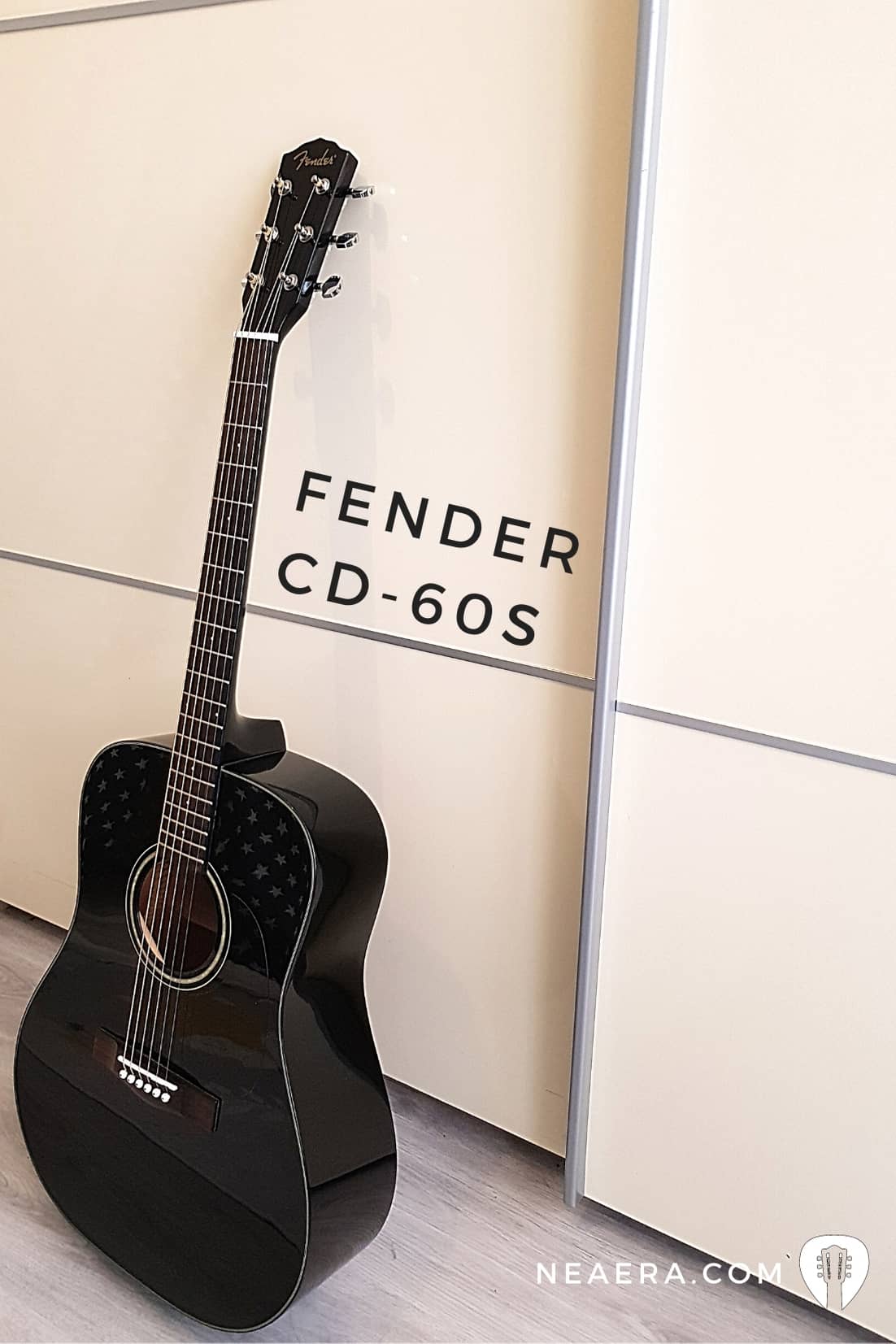
You get with the 60S a solid wood mahogany top, though the back and the sides of the guitar are laminated mahogany. The fretboard feels comfortable and this is probably due to the specially bound fretboard edges.
The CD-60S’s action is also great out of the box. The mahogany mid-character can be heard clearly here and it brings some power with a clarity commonly associated with spruce tops.
The result is something that is genuinely inspiring to play with strumming but especially suitable for chord work.
- Excellent price/quality ratio
- Great intonation
- Excellent for beginners
- The looks can be a bit daunting and I find such a Dreadnought body way too big, but that’s me
Why should new players settle for just good when they can be comfortable and inspired by this Fender?
Taylor GS Mini
- Sitka spruce top at a great price
- Short scale is great for newbies
- No electronics
- Very basic look
Serious quality at a very good price.
- Layered sapele body with a sitka spruce top
- Sapele neck
- 23.5″ (597mm) scale
- Ebony fretboard
- 20 frets
- Chrome tuners
- Electronics: No
- Left-handed: Yes
- Satin finish
As one of the ‘big two’ in acoustic guitars, along with Martin, there is a level of quality and excellence that can reasonably be expected from Taylor.
After all, this is a brand that produces guitars that are just as expensive as a family car.
But with the Taylor GS Mini, they’ve produced a guitar that packs all that high-end know-how and experience at a price that costs just under 500.
The GS Mini is small enough for anyone to be comfortable with, yet still produces the kind of tone that will make you weak in the knees.
- Compact size
- Excellent build quality
- Very easy to play for beginners
- Actually no drawbacks worth mentioning
Instead of adding pickups or other features, they put all the budget into the build quality.
The build quality and overall playability are excellent, making this the perfect guitar for everyone no matter where they are in their playing career.
The Yamaha JR2 Junior Acoustic Guitar is not a full-size guitar, as you might have guessed. This guitar is actually a 3/4 length of the full-size guitar.
Super handy for children and beginners as a travel guitar.
The material used to make this guitar are absolutely of the highest quality and slightly higher than the wood used in the JR1.
And that little bit of extra money is going to help so much in learning, and enjoy playing and learning.
This guitar is made from the spruce top, mahogany sides and back, and has a rosewood bridge and fingerboard.
The nato neck on this guitar is quite comfortable which really helps your hand hit the notes without a problem. However, the strings are a bit stiff, but the neck and bridge are certainly durable and will last a long time.
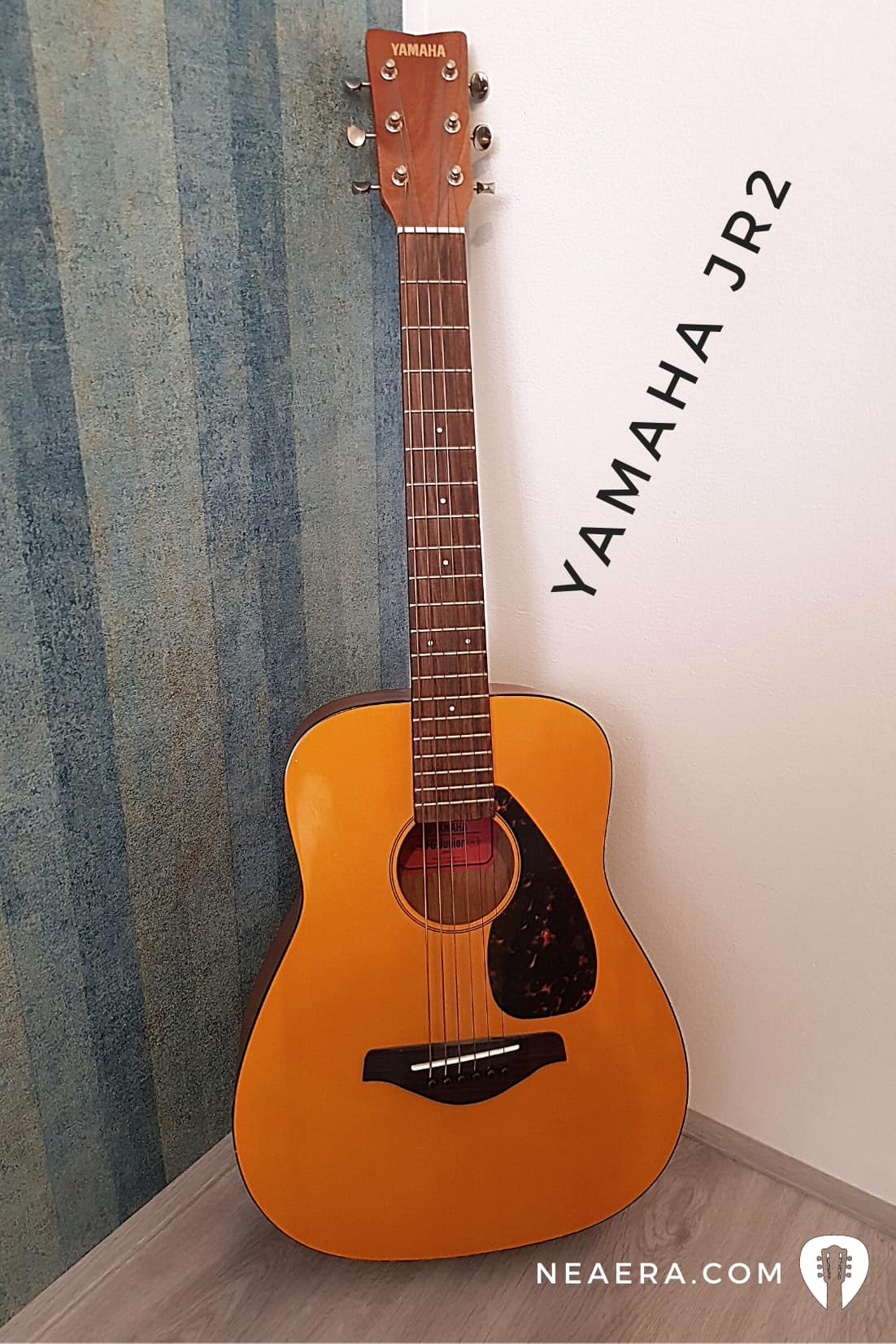
When it comes to playability, this guitar really stands out. Simply put, the Yamaha JR2 Junior Acoustic Guitar is quite simple and playable.
Many people wonder if a junior guitar like this can deliver good sound quality.
Well, I can safely say that Yamaha JR2 is definitely one of the best junior size guitars when it comes to sound quality, and it is therefore also a favorite travel guitar of more experienced players, due to its small size.
This guitar can produce such a powerful sound while keeping the warm and classic tone in the air for a long time. Also, the amazing chrome hardware is here to ensure only the best performance.
The overall design is a bit old-fashioned, but that has its advantages. Namely, this guitar has been designed to give a classic and elegant look, while still being a great modern instrument.
The most distinctive thing about this junior guitar from others is the overall value for the price. So the Yamaha JR2 is definitely one of the most valuable choices that you can make if you buy such a guitar.
You can’t really go wrong with this Yamaha for children.
Yamaha FG800
- Full dreadnought sound
- Nato body is affordable but comparable to mahogany
- Very basic
An affordable beginner acoustic guitar that is above its class.
- Kind: Dreadnought
- Top: solid spruce
- Back and sides: Nato
- Neck: Nato
- Scale: 25.6 “
- Fingerboard: rosewood
- Frets: 20
- Tuners: Die-Cast Chrome
- Electronics: n / a
- Left-handed: no
- Finish: matte
This affordable model from guitar giant Yamaha is a quintessentially stylish, clean acoustic construction with a matte finish that gives a lived-in “used” guitar look.
There is little decoration, the dots on the fingerboard are small and lack contrast, but the white dots on the side are bright and ideal for beginners.
The three-piece neck, with a spacious, full C-profile, immediately puts you in your game. The tuners are fairly basic, but more than ready for the job, while the nut and compensated bridge are well cut with a decent string height.
- Great dreadnought sound
- Built-in look
- You will not outgrow you quickly
- Not the best choice for children
Dreadnoughts come in many different tonal tones, of course, but you should be able to expect a lot of spacious lows, a strong thump in the lower mids, clear highs: a big projecting sound.
Well, the FG800 ticks those boxes and more.
Gretsch G9500 Jim Dandy
- Great 1930s sound and look
- Solid sitka spruce top
- Bit thin on the lows
A fantastic parlor guitar with a lot of 1930s charm.
- Type: Parlor
- Top: Solid Sitka Spruce
- Back and sides: Laminated mahogany
- Neck: mahogany
- Scale: 24.75 “
- Fingerboard: rosewood
- Frets: 19
- Tuners: Vintage Style Open Back
- Electronics: n / a
- Left-handed: no
- Finish: thin glossy polyester
The G9500 is a saloon guitar or parlor guitar, which means it has a much smaller body than, say, a dreadnought. Good news for children and smaller guitarists!
Sound wise this acoustic guitar is great; airy, clear and sparkling, without the harshness you would expect from a combination of spruce and laminate.
Make no mistake, this is a relatively trebly guitar (shrill and high, especially compared to Dreadnoughts) and especially the low E string is quite quiet, but that’s not a bad thing.
- Great sound
- Great looks
- Really nice to play
- Needs more punch from the low E
It would be easy to be snobby about the back and sides of the laminate, but you don’t have to at all.
Instead, try this guitar for yourself and you’ll like it better than much more expensive rivals, even some with completely solid wood.
Epiphone Hummingbird Pro
- Very well built for this price
- Spruce and mahogany give deep tones
- Pickups sounds a little thin
- Top: solid spruce
- Neck: mahogany
- Fingerboard: rosewood
- Frets: 20
- Electronics: Shadow ePerformer Preamp
- Left-handed: No
- Finish: Faded Cherry Sunburst
If you’ve heard of The Beatles, or Oasis, or Bob Dylan, or almost every classic rock act of the last 60 years, you’ve heard some famous Hummingbird acoustics in action.
The Epiphone Hummingbird Pro is both tonally and visually striking and would be an excellent choice for learning.
- Beautiful design
- Rich, deep tone
- Works well for finger pickers
- No significant drawbacks for this price
There’s more to this guitar than the beautiful graphics and timeless vintage finish.
The sound it produces is versatile and balanced, making it ideal for strummers and fingerpickers alike, while the small details like split parallelogram inlays and oversized headstock combine to make a striking visual statement.
Epiphone EJ-200 SCE
- Fishman pickup is really great
- Lots of sound from the acoustics
- Extremely large
This jumbo-acoustic guitar delivers a great tone and volume to match
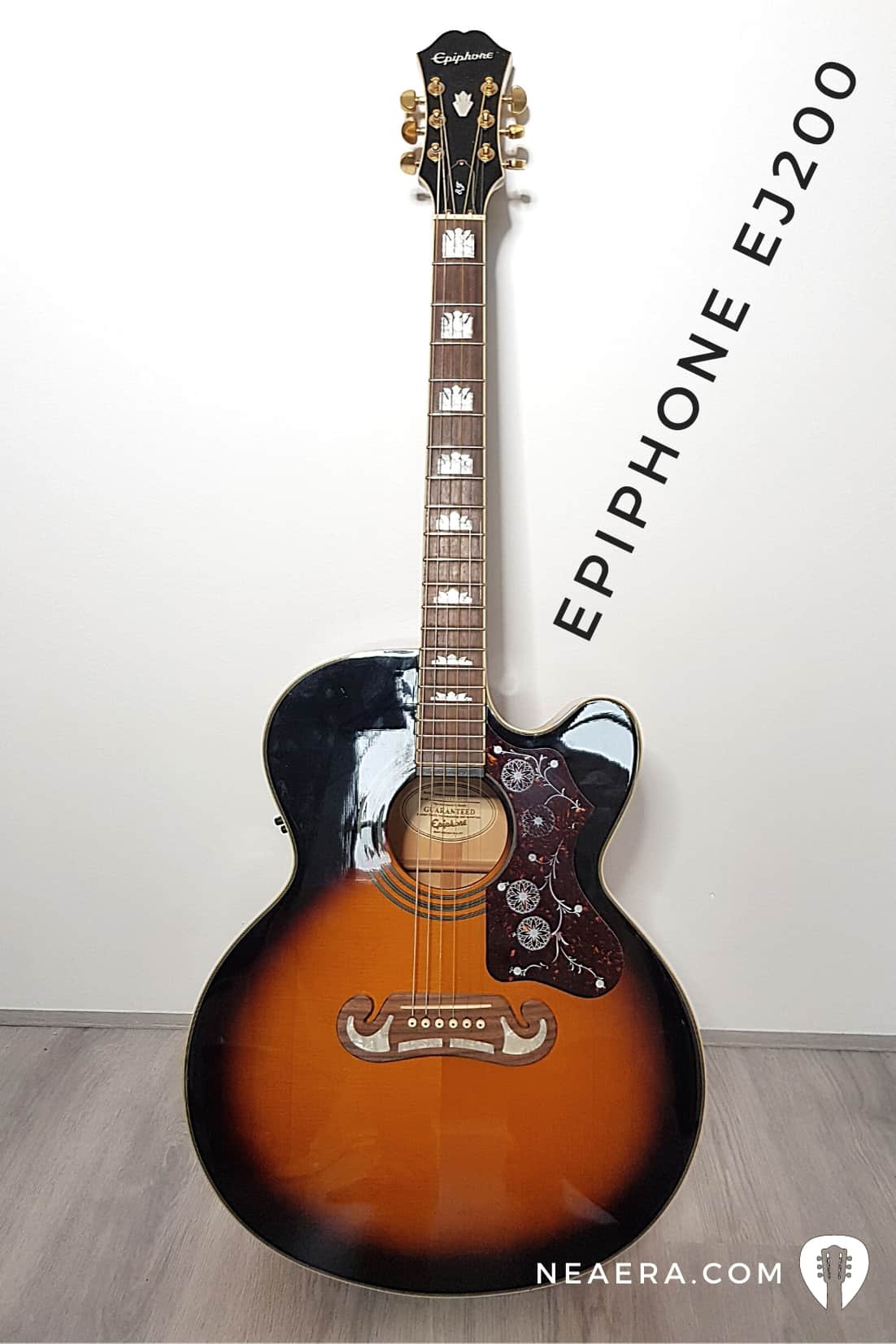
- Top: solid spruce
- Neck: Maple
- Fingerboard: Pau Ferro
- Frets: 21
- Electronics: Fishman Sonitone
- Left-handed: No.
- Finish: natural, black
Sometimes when you play an electro-acoustic guitar you will find that the tone comes across as a bit thin, as if the electronics are taking away some of the natural sound and the way an acoustic guitar body makes the sound reverberate.
But that’s not the case with the Epiphone EJ200SCE, which sounds big when plugged into a PA as well as on its own in a small practice room or stage.
Where the Fender CD60S is a good affordable choice for chord work, with this Epiphone you can also do more with some solo and single notes.
It’s really big so not for the smaller people among us, that’s the tradeoff between such deep bass sounds and a large body.
- Sounds incredible
- Classic looks
- This is certainly a large guitar so not for everyone
The pickups are from the Fishman Sonitone system and give the option of 2 outputs, simultaneously stereo where you can blend the two to your taste, or separately through the two outputs to mix each in the PA. A lot of versatility for such an affordable guitar.
This design is another classic from Epiphone, which will appeal to anyone with a love of heritage music.
It’s a great guitar – the ‘J’ stands for jumbo, after all, and as such perhaps too much for kids, but for adults looking to pick up the instrument, the EJ-200 SCE is an extremely rewarding choice.
Conclusion
As you can see, it is difficult to pick one best guitar for beginners. Not only because of budget, but also because there are so many different playing styles.
I hope this guide has helped you find a guitar that suits the path you want to walk and you can buy one that you will enjoy for a long time to come.
Also read: when starting out, you probably want a good multi-effects unit to get the right sounds
I'm Joost Nusselder, the founder of Neaera and a content marketer, dad, and love trying out new equipment with guitar at the heart of my passion, and together with my team, I've been creating in-depth blog articles since 2020 to help loyal readers with recording and guitar tips.


